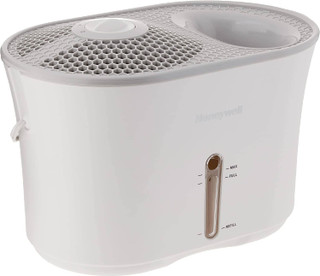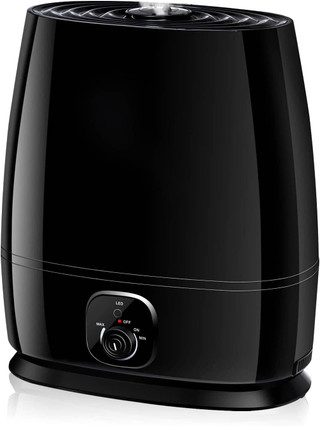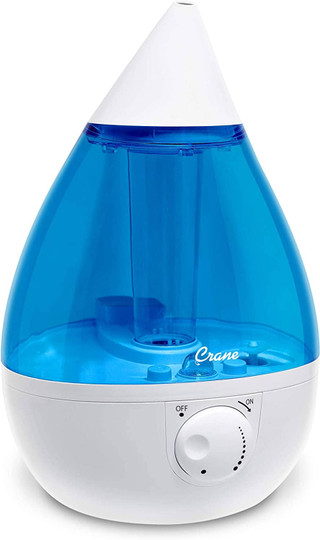Best Mushroom Humidifiers for Your Grow Tent: Ultimate Guide
Posted by Troy Cosky, Founder FunGuy Grow Supply on 27th Jun 2023
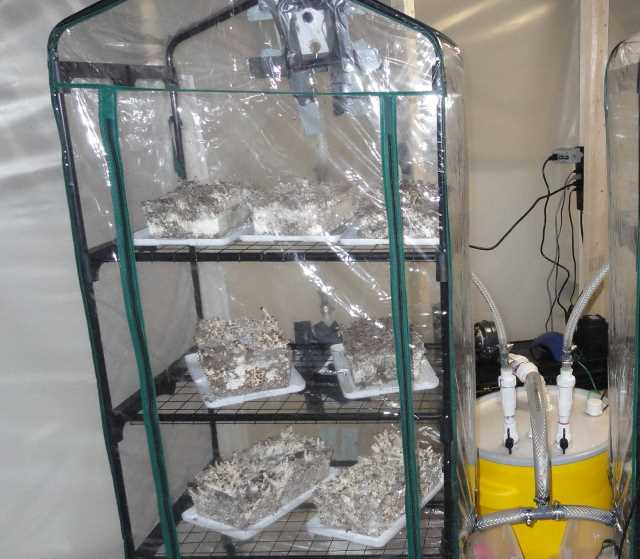
A Comprehensive Guide To The Best Mushroom Growing Humidifiers
Welcome to the comprehensive guide on mushroom growing humidifiers, where we'll explore everything you need to know about selecting and using the best humidifier for your mushroom cultivation needs. Whether you're an experienced mushroom grower or just starting out, understanding the role of humidity is crucial for successful cultivation.
Mushrooms thrive in high humidity environments, absorbing water through their substrate and fruiting bodies. Without adequate moisture levels, your mushrooms may struggle to develop or even dry out completely. That's why investing in a quality humidifier is essential.
In this guide, we'll dive deep into different types of humidifiers available on the market, including ultrasonic and evaporative models. We'll also provide insights into the features to consider when selecting the perfect humidifier for your setup. Plus, we'll unveil our top recommendation: the Senofun Mister Ultrasonic Mushroom Humidifier.
By maintaining a consistent level of relative humidity in your grow room or tent, you'll create the ideal environment for successful mushroom growth. With this guide as your go-to resource, you'll be well-equipped to make informed decisions and maximize your mushroom cultivation efforts.
Get ready to enhance your mushroom growing journey with the power of optimized humidity control. Let's dive in!
Key Takeaways
- Quality humidifiers are crucial for successful mushroom cultivation and can improve yields and crop health.
- Different types of mushrooms require different humidity levels, so it's important to choose a humidifier that allows for customizable mist output settings and LED indicators.
- Regular cleaning of humidifiers is important to prevent bacterial and mold growth, and investing in automated controllers or monitoring systems can help maintain consistent humidity levels.
- Proper humidity levels are necessary for healthy and thriving mushrooms, so selecting the right humidifier and maintaining optimal environmental conditions throughout the lifecycle is essential for larger yields of high-quality harvests.
Introduction to Humidifiers for Mushroom Cultivation
If you want to take your mushroom growing to the next level, it's crucial to understand why a humidifier is essential for maintaining the best humidity levels and explore the various options available.

A mushroom humidifier is designed for regulating moisture levels in the fruiting chamber or grow room. Without proper humidity, mushrooms tend to dry out or get contaminated with molds and other organisms.
A humidifier for mushroom growing helps in creating an environment that mimics natural conditions required for mycelium growth and fruiting body development. Different species of mushrooms require different humidity levels, ranging from 70% to 95%, depending on their stage of growth. Maintaining a consistent and optimal level of humidity ensures healthy growth, higher yields, and better quality mushrooms.
The best humidifier for mushrooms varies based on several factors such as the size of your grow room or fruiting chamber, the type of mushrooms being grown, budget constraints, and personal preferences among others. An automatic humidifier for mushroom cultivation is usually preferred over manual methods like spray bottles because it saves time and ensures accuracy in controlling humidity levels.
Understanding the role of humidity in mushroom growing is important before choosing a suitable humidifier. Humidity affects not only water absorption but also temperature regulation and gas exchange within the substrate and fruiting bodies. Inadequate moisture can lead to slow growth or stunted development while excess moisture can cause contamination, bacterial infections, or rotting. Therefore, selecting an appropriate mushroom humidifier requires careful consideration based on your specific needs and requirements.
Understanding the Role of Humidity in Mushroom Growing
Maintaining consistent levels of moisture is essential for successful mushroom growth. They thrive in environments with high humidity, so understanding how humidity affects mushroom cultivation is crucial when selecting the right humidifier.

Consistent relative humidity levels are necessary for proper fruiting, but too much or too little can be detrimental. A mushroom humidifier regulates moisture in your grow room, martha tent, or greenhouse, ensuring optimal growing conditions for your fungi. The best humidifier provides a consistent level of humidity that falls within the preferred range for each species.
Humidity plays an important role throughout the mushroom life cycle, from spores to fruiting bodies. Understanding what level of moisture each stage requires and adjusting accordingly is critical. Improper humidity for a mushroom can cause cracked caps or bacterial growth, harming your crop. By maintaining consistency throughout all phases, healthy crops are produced consistently.
Understanding humidity in growing mushrooms is critical to producing healthy crops. Using a suitable humidifier ensures fungi remain thriving and productive throughout their life cycle. In subsequent sections about the 'variety of humidifiers,' we will discuss various options available on the market today, highlighting their benefits and drawbacks, and which ones work best depending on personal preferences.
Variety of Humidifiers for Mushroom Growers
Discovering the perfect humidifier for your mushroom setup can be a game-changer, allowing you to provide the ideal growing conditions for your fungi while watching them flourish.
There are various types of humidifiers that have been used by mushroom growers, each with its advantages and disadvantages. Here are some options to consider:
- Ultrasonic Humidifiers: This type of humidifier is highly recommended for mushroom growing due to its efficiency in producing a fine mist that maintains high humidity levels without overwetting the surroundings. It is an excellent choice for those who want to maintain a consistent level of moisture in their fruiting chamber. The 'Senofun Mister' ultrasonic humidifier is popular among growers because it provides effective coverage at an affordable price.
- Multidisc Floating Ultrasonic Humidifiers: For large-scale operations or setups that require extensive coverage, multidisc floating ultrasonic humidifiers are ideal. They can distribute water vapor over a larger area efficiently, making them suitable for commercial setups or large grow rooms.
- Wicking Humidifiers: Wicking humidifiers function by absorbing water from a reservoir and dispersing it naturally into the air through evaporation. This type of humidifier is beneficial in maintaining optimal humidity levels within the fruiting chamber with no added noise or electricity needed.
When buying a humidifier, ensure that it has an appropriate water tank size and dial on/off switch so you can adjust ideal humidity levels as needed. Also, consider how easy it will be to clean and maintain your chosen model as well as any additional features such as multi-directional fogging heads or warranties.
When searching for the best mushroom fruiting chamber humidifier, there are several options available based on personal preferences and requirements. However, ultrasonic humidifiers tend to be most effective due to their ability to produce fine mist while maintaining healthy humidity levels without overly wetting surroundings. A deep dive into the 'Senofun Mister' ultrasonic mushroom humidifier will be discussed in the subsequent section.
A Deep Dive into the 'Senofun Mister' Ultrasonic Humidifier for Growing Mushrooms
You're probably wondering what sets the Senofun Mister Ultrasonic Mushroom Humidifier apart from other options on the market. Well, for starters, this humidifier is specifically designed for mushroom cultivation and has a high-quality build that ensures longevity. The Senofun Mister offers various mist output settings, allowing you to customize humidity levels according to your specific needs.
But what makes the Senofun Mister stand out from other ultrasonic humidifiers for mushroom growing? One of its unique features is the LED indicators that allow you to monitor water levels and mist output at a glance. Additionally, this humidifier has a safety feature that automatically shuts off when water levels are low, preventing damage or accidents. This ensures that your mushrooms are never exposed to dry air which can be detrimental to their growth.
If you're looking for an easy-to-maintain mushroom fruiting chamber humidifier, then the Senofun Mister should be at the top of your list. It's recommended to use distilled or demineralized water to prevent mineral buildup and avoid leaving it plugged in for prolonged periods as a safety measure.
The Senofun Mister ultrasonic humidifier is an excellent investment if you're serious about cultivating mushrooms. Its user-friendly design, safety features, and easy maintenance make it an excellent choice for any mushroom grower. However, there are other recommended humidifiers worth considering based on your specific needs and budget.
| Feature | Senofun Mister Ultrasonic Humidifier |
|---|---|
| Mist Output Settings | Customizable |
| LED Indicators | Yes |
| Safety Feature | Automatic Shut-off |
| Recommended Water Type | Distilled or Demineralized |
Now let's take a closer look at some other top-rated options for mushroom growers seeking reliable and efficient humidifiers.
Other Recommended Humidifiers for Growing Mushrooms
You'll be pleased to know that there are other fantastic top-rated humidifiers available for keeping your mushroom fruiting chamber at the perfect humidity level. In addition to the Senofun Mister ultrasonic humidifier, there are a variety of other humidifiers suitable for mushroom cultivation. To help you make an informed decision, we've compiled a list of some of the best humidifiers for growing mushrooms in the table below.
| Humidifier | Tank Size | Mist Output | Recommended Room Size |
|---|---|---|---|
| Vicks Cool Mist v600 | 1.2 gallons | Up to 2 gallons per day | Small to medium rooms |
| HemingWeigh Ultrasonic Humidifier | .59 gallon/2.2L. | Up to 24 hours continuous mist output | Medium-sized rooms |
| Cool Mist Ultrasonic Humidifier | .59 gallon/2.2L. | Up to 24 hours continuous mist output | Medium-sized rooms |
| AquaOasis Cool Mist Humidifier | .59 gallon/2.2L. | Up to 16 hours continuous mist output | Small rooms |
| Crane Tear Drop Ultrasonic Humidifier | 1 gallon | Up to 24 hours continuous mist output | Large rooms |
These humidifiers are all great choices for maintaining optimum humidity levels in your mushroom fruiting chamber. The Vicks Cool Mist v600 is ideal for small to medium-sized rooms, with a generous tank size and impressive mist output. The HemingWeigh Ultrasonic Humidifier boasts long-lasting performance and comes with a one-year warranty, making it a reliable choice for any grower. The Crane Tear Drop Ultrasonic Humidifier provides up to 24 hours of continuous mist output, making it ideal for larger grow rooms or commercial operations. Meanwhile, the AquaOasis Cool Mist Humidifier is easy to clean and produces up to 16 hours of continuous mist on a single fill.
While these four models are some of the best humidifiers available for mushroom growing, there are many other options out there that may work better depending on your specific needs and preferences. When choosing a humidifier for growing mushrooms, factors like room size, ease of maintenance, and mist output should all be considered carefully.
Maintaining optimum humidity levels is crucial when cultivating mushrooms, as they require high levels of moisture to thrive. Whether you're just starting out or have been growing mushrooms for years, investing in a quality humidifier can significantly improve yields and overall crop health. With so many options available on the market today, finding the perfect fit shouldn't be too difficult. To learn more about how you can keep your mushroom fruiting chamber at the perfect humidity level, read on to our next section.
Maintaining Optimum Humidity Levels for Mushroom Cultivation
Maintaining the ideal moisture levels for your mushrooms is crucial to their growth and development, and it can be achieved with proper humidifier maintenance and regular fanning for fresh air exchange (FAE). Here are some tips on how to maintain optimum humidity levels for mushroom cultivation:

- Clean your mushroom humidifier regularly to prevent bacterial and mold growth. This will also help prolong the lifespan of your humidifier.
- Use a hygrometer to monitor the humidity levels in your fruiting chamber. Aim for relative humidity (RH) between 80% and 90% during fruiting.
- Place your humidifier inside or outside your fruiting chamber, depending on its size. Make sure it has a dial ON switch and an appropriate tank size for efficient operation.
- Ultrasonic humidifiers are recommended for mushroom growing due to their ability to humidify by creating a light mist that won't soak substrates or damage fruiting bodies.
- Perlite can be utilized in a fruiting chamber to help maintain humidity levels. Perlite is an inexpensive, naturally occurring mineral that absorbs water and releases it slowly over time. This makes it an ideal choice for maintaining consistent moisture levels within the growing environment.
- Fanning helps circulate fresh air throughout the chamber, providing oxygen for mushroom growth while preventing stagnant air pockets that can lead to mold or bacterial growth.
By following these tips, you can ensure that your mushrooms receive adequate moisture throughout their growth cycle. However, there may be challenges along the way when using a humidifier for mushroom cultivation.
Now that you know how to maintain proper humidity levels, let's move on to dealing with challenges in a mushroom grow humidifier usage without compromising your crop's health and quality.
Dealing with Challenges in Mushroom Grow Humidifier Usage
Encountering challenges in the usage of a humidifier for mushroom cultivation can be frustrating, but there are effective ways to deal with them.
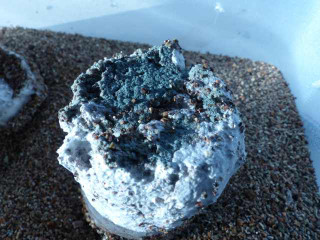
One major issue is bacterial and mold contamination within the humidifier. This can lead to poor fruiting conditions and substrate contamination and even complete crop failure. To prevent this, it's important to regularly clean and sterilize the humidifier before each use. You can use a diluted hydrogen peroxide solution or other sterilization methods recommended by the manufacturer.
Another challenge in using a mushroom growing humidifier is humidity fluctuations that can impact fruiting development in the mushroom grow room. High humidity levels can cause CO2 levels to rise, leading to aborting of fruiting bodies or stunted growth. To overcome this problem, consider investing in an automatic humidifier controller that maintains consistent humidity levels.
In addition to bacterial blotch and pests, another potential issue is maintaining optimum climate and temperature conditions while using a humidifier for growing mushrooms. A good strategy here would be to invest in a high-quality temperature and humidity controller or monitor that alerts you when conditions fall outside the desired range.
Ultrasonic humidifiers are popular due to their ability to create a light mist that doesn't disrupt airflow in grow rooms. However, larger setups may require commercial-grade options like Ideal-Air or House of Hydro foggers that feature multi-directional fogging heads and industrial-grade motors.
Overall, choosing the best humidifier for mushrooms depends on several factors such as budget, space availability, and personal preferences. However, by understanding potential challenges and implementing strategies like regular cleaning of equipment and investing in automated controllers, humidity sensors, or monitoring systems, you can ensure consistent high humidity levels without compromising on air circulation or risking contamination from bacteria and molds within your grow setup.
Understanding how to overcome challenges associated with using a mushroom growing humidifier is essential if you want healthy crops. However, there are other factors to consider too. Let's take a closer look at how selecting the right type of humidifiers impacts successful mushroom cultivation in our next section - Conclusion: The Impact of The Right Humidifier on Successful Mushroom Cultivation.
Conclusion: The Impact of the Right Humidifier on Successful Mushroom Cultivation
Choosing the right humidifier can make all the difference in successfully cultivating healthy and thriving mushrooms. A mushroom humidifier is an essential tool for any grower, as it ensures that the environment is kept at optimal conditions for growth.

Without proper humidity levels, your mushrooms may struggle to grow, become stunted, or even succumb to disease. When looking for a humidifier for growing mushrooms, you want to consider a few key factors.
First and foremost, you need to choose a humidifier that is capable of producing enough moisture for your specific growing setup. Don't skimp on this crucial component of your mushroom cultivation process; investing in a high-quality humidifier will pay off in spades with bigger yields and healthier crops.
The best mushroom humidifiers are those that offer precise control over humidity levels, so look for models with adjustable settings or built-in sensors that help maintain ideal conditions automatically. Additionally, you'll want to find a humidifier that's easy to clean and maintain since fungus growth can occur inside the machine if not cared for properly.
Choosing the right humidifier mushroom growers can trust is essential if you want to achieve successful cultivation results. With so many options available on the market today, take the time to research and compare different models before making your purchase.
To help you make an informed decision when selecting the best humidifier for your mushroom grow tent or indoor farm, we've compiled a table comparing some key features of popular models on the market today.
| Humidifier Model | Capacity (Gallons) | Coverage Area (sq. ft.) | Type | Price ($) |
|---|---|---|---|---|
| TaoTronics Cool Mist Humidifier | 1.06 gal./4L. | Up to 322 sq.ft. | Ultrasonic Cool Mist | $49.99 |
| Mushroom Monsoon Humidifier | 1 gallon/3.8L. | Up to 500 | Ultrasonic Cool Mist | $29.99 |
| Vornado Evaporative Humidifier | 4 gallon/15L. | Up to 1000 sq.ft. | Evaporative | $129.99 |
By doing so, you'll ensure that your mushrooms receive optimal environmental conditions throughout their entire lifecycle – ultimately leading to larger yields of high-quality harvests!
Boost Your Mushroom Cultivation with the Best Humidifiers and Essential Accessories from FunGuy Grow Supply
Mushroom growing made easy with FunGuy Grow Supply. From the best humidifiers for mushroom growing to grain spawn, mushroom grow kits, and essential supplies, we have all you need to boost your mushroom cultivation. Shop now to optimize your mushroom growing environment!
Frequently Asked Questions

Can humidifiers be used for growing all types of mushrooms?
Yes, humidifiers can be used for growing most types of mushrooms. Maintaining proper humidity levels is crucial for successful mushroom growth and a humidifier can help achieve the ideal humidity range of 70-85%.
However, it's important to note that some mushroom species have specific requirements for temperature and humidity, so it's best to research the specific needs of the type of mushroom you're growing.
Additionally, using a quality humidifier specifically designed for mushroom cultivation is recommended as they often come equipped with features such as automatic shut-off and precise control settings.
Overall, incorporating a humidifier into your mushroom growing setup can greatly improve yield and quality.
What is the difference between a humidifier and a misting system for mushroom cultivation?
A misting system for mushroom cultivation is different from a humidifier in several ways. Firstly, while a humidifier increases the overall humidity level of the growing environment, a misting system provides targeted moisture to specific areas where it's needed most.
Secondly, a misting system typically uses smaller droplets of water than a humidifier, which can be more easily absorbed by mushrooms and reduce the risk of excess moisture buildup. Additionally, misting systems often incorporate timers or sensors to ensure that moisture levels remain consistent and prevent over-saturation.
Overall, while both tools can be useful for maintaining optimal growing conditions for mushrooms, a misting system offers more precise control over moisture levels and can help prevent common issues like mold growth or uneven hydration.
How often should humidifiers be cleaned to prevent contamination?
To prevent contamination, it's crucial to clean your mushroom growing humidifiers regularly. The frequency of cleaning will depend on the type of humidifier you're using and how often you use it.
As a general rule, ultrasonic humidifiers should be cleaned every two weeks while evaporative wick or filter-based humidifiers can go up to a month between cleanings. When cleaning your humidifier, always follow the manufacturer's instructions for disassembling, cleaning, and reassembling.
Use only mild soap and water or a vinegar solution to avoid damaging any parts. Regular maintenance and cleaning will help ensure that your mushrooms grow healthy and free from contaminants.
Are there any safety precautions that need to be taken when using humidifiers for mushroom cultivation?
When using humidifiers for mushroom cultivation, it's crucial to take certain safety precautions. First and foremost, always make sure that the humidifier is clean and free of any contaminants before use.
Additionally, be sure to place the humidifier in a location where it won't tip over or cause any damage. It's also important to monitor the humidity levels closely and avoid over-humidifying your growing environment, as this can lead to mold growth and other issues.
Finally, always follow the manufacturer's instructions carefully when setting up and using your humidifier to ensure safe and effective operation. By taking these simple steps, you can help ensure that your mushroom-growing project is a success while minimizing any potential risks or hazards along the way.
Can the same humidifier be used for both small-scale and large-scale mushroom cultivation?
Yes, you can use the same humidifier for both small-scale and large-scale mushroom cultivation. However, it's important to ensure that the size of the humidifier matches the size of your growing area.
For small-scale cultivation, a tabletop humidifier may be sufficient. But for larger areas, such as commercial operations, a larger industrial-grade humidifier will be necessary.
Additionally, it's important to consider the type of humidifier being used and its features. Ultrasonic and cool mist humidifiers are popular choices for mushroom cultivation due to their ability to distribute moisture evenly throughout the growing area.
Regardless of which type or size of humidifier you choose, it's crucial to properly maintain and clean it regularly to prevent contamination in your mushroom substrate and crop.
Can I use tap water in my mushroom humidifier or do I need to use distilled water?
Yes, you can use tap water or hard water in your mushroom humidifier. However, it's important to note that tap water may contain minerals and other impurities that can build up over time and potentially harm your mushrooms or the humidifier itself.
To avoid this, it's recommended to use distilled or purified water instead. This will ensure that the humidifier functions properly and provides clean humidity for optimal mushroom growth.
Additionally, using distilled water can prolong the lifespan of your humidifier by preventing mineral buildup and reducing the need for frequent cleaning.
How often do I need to clean my mushroom humidifier?
You should clean your mushroom humidifier at least once a week to prevent the buildup of bacteria and mold.
Make sure to empty any remaining water from the tank, remove any filters or cartridges, and rinse them thoroughly with hot soapy water. Use a soft brush or cloth to clean the exterior of the humidifier, paying special attention to any crevices or hard-to-reach areas.
Be sure to replace any filters or cartridges according to the manufacturer's instructions.
Proper cleaning is essential for maintaining optimal growing conditions for your mushrooms and preventing contamination that could ruin your crop.
Can I use a DIY humidifier for mushroom growing?
Using a DIY humidifier for mushroom growing is not recommended. The importance of maintaining high humidity levels for successful mushroom growth can't be overstated, and using a subpar or untested device can have disastrous consequences.
Commercial humidifiers like the Ideal-Air or House of Hydro fogger are popular choices for larger operations. Smaller monotub or grow tent setups may benefit from ultrasonic humidifiers like the Vicks Cool Mist v600 or HemingWeigh Ultrasonic Humidifier.
It's important to choose a humidifier with an appropriate tank size and dial ON switch for easy maintenance and cleaning. While wicking humidifiers exist, they are not commonly used in mushroom growing due to their inefficiency compared to other methods.
In summary, it's best to stick with proven options rather than risk damaging your crop with an untested DIY solution.
References
- Hoa, H. T., & Wang, C. L. (2015). The Effects of Temperature and Nutritional Conditions on Mycelium Growth of Two Oyster Mushrooms (Pleurotus ostreatus and Pleurotus cystidiosus). Mycobiology, 43(1), 14–23. https://doi.org/10.5941/MYCO.2015.43.1.14
- Bellettini, M. B., Fiorda, F. A., Maieves, H. A., Teixeira, G. L., Ávila, S., Hornung, P. S., Júnior, A. M., & Ribani, R. H. (2019). Factors affecting mushroom Pleurotus spp. Saudi journal of biological sciences, 26(4), 633–646. https://doi.org/10.1016/j.sjbs.2016.12.005
- Baars, J. J. P., Scholtmeijer, K., Sonnenberg, A. S. M., & van Peer, A. V. (2020). Critical Factors Involved in Primordia Building in Agaricusbisporus: A Review. Molecules (Basel, Switzerland), 25(13), 2984. https://doi.org/10.3390/molecules25132984
- Sánchez C. (2010). Cultivation of Pleurotus ostreatus and other edible mushrooms. Applied microbiology and biotechnology, 85(5), 1321–1337. https://doi.org/10.1007/s00253-009-2343-7


